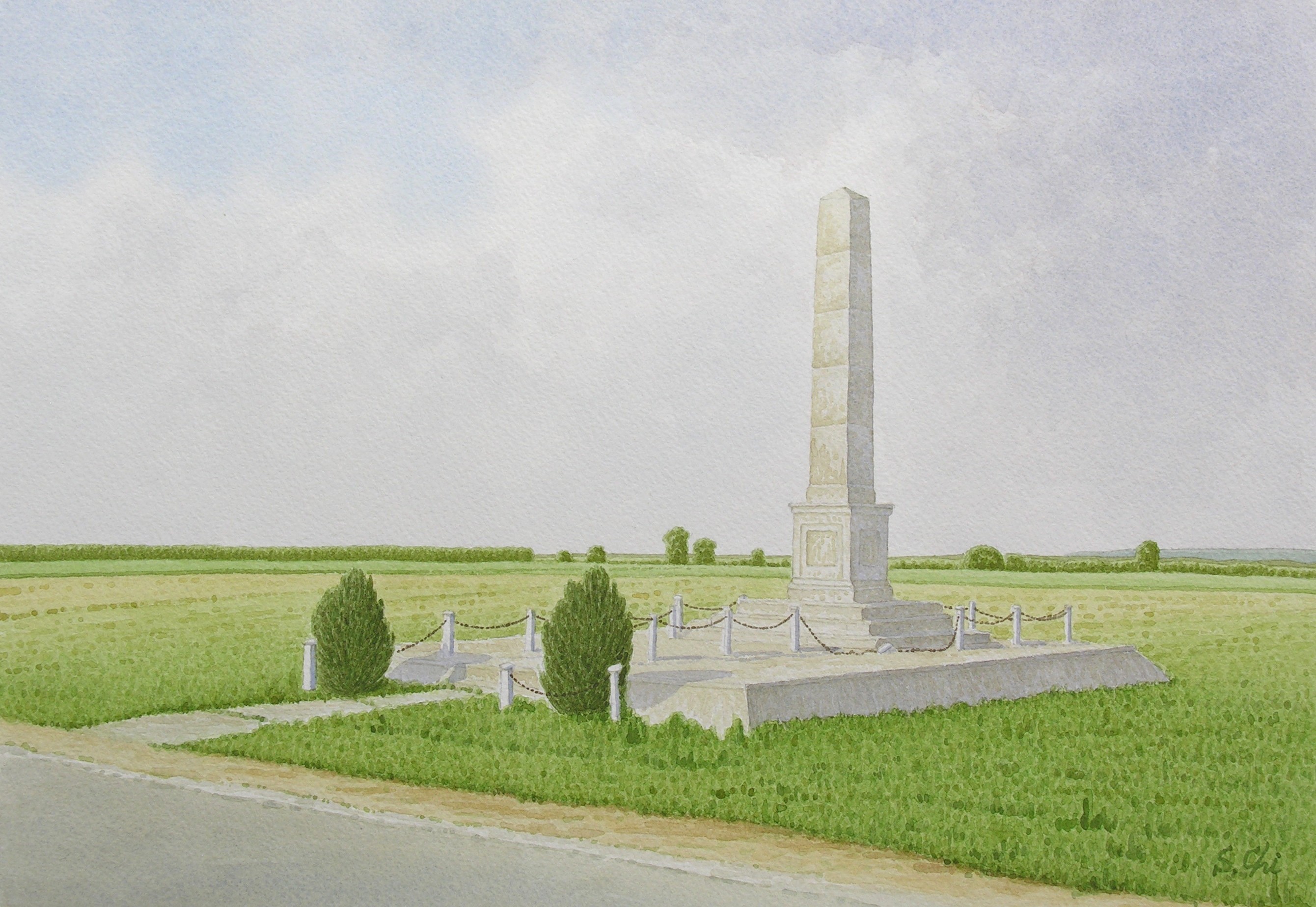
遥かなる わがヨークシャー (Faraway My Yorkshire)
ヨーク近郊 (Outskirts of York)
25 マーストン・ムーア (Marston Moor)

ある日ヨークへ行った帰りに、交通量の多い幹線道路のA64号線を通らず、その北側ののどかな田園地帯のなかを走っているB1224号線を通ったことがある。
この道の北側、ちょうどヨークとウェザビーの中間にある田園一帯は、マーストン・ムーアと呼ばれている。
途中のロング・マーストンの村で右折し、北へとつづくわき道をゆくと。すると道沿いに、高さが7、8mくらいのオベリスクのような石柱が立っている。ヨークから西へ10kmくらいのところである。
その石柱は、ピューリタン革命時代の1644年7月2日にこの場所であった「マーストン・ムーアの戦い」を記念するものであった。ピューリタン革命では大きな戦いが15、6回あったが、この戦いは、そのなかでも最大のものだったとされている。
戦いのようすは、次のようなものである。
この日、マーストン・ムーアの原野の北側に陣取ったのは、チャールズ1世の甥で国王軍の総司令官であったルパート王子の指揮する国王軍だった。兵力については諸説あるが、1万7千から1万8千とするのが妥当なようである。ルパート王子、議会軍から「王党派のゴリアテ(巨人戦士)と恐れられ、英国史でももっともすぐれた騎兵隊指揮官とされている。
原野の南側に陣取ったのは、2万7千から2万8千と推定される議会側連合軍である。この連合軍を構成していたのは、スコットランドのレーヴン伯アリグザンダー・レズリーの率いる1万7千のスコットランド軍、サー・トマス・フェアファックスの率いる約5千のヨークシャー議会軍、それに、2代マンチェスター伯エドワード・モンタギューとオリヴァー・クロムウェルの指揮する約6千の東部連合軍であった。
両軍とも中央が歩兵本隊で、その両翼に騎兵隊がつく陣形で、マーストン・ムーアの中央を流れていた小さな沢をはさんで対峙していた。
この日は、両軍のあいだで長い睨み合いがつづき、午後には散発的な銃撃戦はあったが、本格的な戦闘にまでは発展することもなく、夕方を迎えていた。
連合軍の司令官たちは、のちに「クロムウェルの小丘」と呼ばれるようになる小高いところに集まり、国王軍のようすをうかがっていた。
国王軍は戦闘隊形を解いてはいなかったが、攻撃してくるような気配も見られなかった。連合軍の司令官たちは、「きょうはこのままで終わりか?」と話しあっていた。
と、そのとき、国王軍のうしろのほうで、煙が何本も立ちのぼるのが見えた。国王軍の兵士たちが、夕食の準備のために火をおこしはじめたのである。
これを見た連合軍の司令官たちは、「国王軍は、きょうはもう戦う気がないらしい。攻撃するならば今がチャンスだ!」ととった。そして急いで攻撃態勢に入ると、両翼の騎兵隊が前方の国王軍めがけて、いっせいに突撃していった。中央の歩兵本隊も前進し、総攻撃にそなえた。
不意を突かれた国王軍は、大混乱に陥った。それでも初めのうちは、互角の戦いをつづけていた。しかし、数でまさる連合軍がつぎつぎと波状攻撃でていくと、国王軍はしだいに不利になっていった。
そこでルパート王子は、態勢を立て直そうと、いったん彼の騎兵隊を後退させた。
ところが、これが国王軍の総崩れを招くことになってしまった。ルパート王子の騎兵隊が後退するのを見た国王軍の兵士たちは、それを敗走ととったのだ。そしてある者はルパート王子の騎兵隊を追い、またある者はヨークめざしていっせいに走りだしたのである。連合軍は、これを猛追していった。
まだ日が長い季節であったが、戦いが終わったころには日もとっぷりと暮れていた。この戦いで国王軍は大敗を喫し、チャールズ1世は断頭台へとつづく道を歩むことになった。
マーストン・ムーアは、かつてはその名が示すように、ハリエニシダやサンザシなどが生い茂る不毛の荒野であったという。しかしいまは、豊かな田園地帯になっている。畑のなかには、サンザシのヘッジ・ロウ(生け垣)がつづき、ポツリポツリと、民家や木立がある。そして北にはハンブルトン丘陵が、西にはペナイン山脈が、南から東にかけてはヨーク平地の地平線がかすんでいる。
そののどかな風景を眺めていると、ピューリタン革命の時代にここではげしい戦いがあったとは、想像できないくらいだ。ただ思い出されるのは、芭蕉の俳句「夏草や 兵(つわもの)どもが 夢の跡」である。
ヨークシャーは、古代からいくつもの戦いがあったところである。先にふれたように、ブリガンテス族とローマ軍がはげしい戦いをくりかえしたのは、ここヨークシャーであった。
マーストン・ムーアの戦いのほかにも、ヨークシャーでは次のような戦いがあった。
ハトフィールド・チェイスの戦い*、ウィンワイト河畔の戦い*、スタムフォード・ブリッジの戦い*、バラブリッジの戦い*、ウェイクフィールドの戦い*、タウトンの戦い*――などである。これらの戦いについては、脚注を参考にされたい。
One day, when I returned to Leeds from York, shunning the heavy traffic
on the A64, I drove along the B1224, which runs in the peaceful fields
and meadows, via Wetherby.
Turning to the right at a village of Long Marston, I went along the narrower
country road leading to Tockwith. Then on the way, 6 or 7 miles to the
west of York, I found an obelisk of probably some 25 feet in height on
the roadside. The obelisk was erected to commemorate the Battle of Marston
Moor.
The battle, the greatest one during the Cilil War, was fought here on the
2nd of July in 1644.
The Royalists army of 17,000 to 18,000 soldiers, which was commanded by
Prince Rupert, a nephew of Charles I, took up their position in the north
of the moor. Rupert is reputed to be the most talented cavalry's commander
in English history and the Parliamentarians were afraid of him, calling
him the Royalists' "Goliath".
The Allied armies from 27,000 to 28,000 took up their position in the south.
The Allied armies were comprised of the Scots army of 17,000, which was
commanded by Alexander Leslie, Earl of Leven, the Yorkshire Paliamentarians
Army of about 5,000 commanded by Sir Thomas Fairfax, and the Army of Eastern
Association of about 6,000, which was organised by Edward Montagu, 2nd
Earl of Manchester and Oliver Cromwell.
Being deployed along a small ditch in the moor, two armies of both sides
were watching each other.
The battle was fought as follows. There was a flurry of gunfire during
the afternoon, but there was no sign to develop to fight.
Towards evening, the commanders of Allied armies gathered on a small hill
which was later called Cromwell's Plump to watch the Royalist army.
Then they saw columns of smoke ascending. It showed the Royalist's soldiers
made fires to prepare their supper.
This was the definitive moment of this battle. Taking it the time had come,
the Allied armies' cavalries of both wings charged at the Royalists. Infantries
of the centre also advanced and prepared for all-out attack.
Being caught off guard, the Royalists army was thrown into a state of confusion,
but they fought bravely in disorder. The numerous Allied armies made a
seris of attacks against the Royalists.
With the odds against the Royalists, Prince Rupert withdrew his cavalry
to try to rebuild it. However, some of the soldiers thought Rupert's tactics
were his retreat. And they fled from the field, some following Rupert's
cavalry and some running away for York. This invited the collapse of the
Royalists army, and the battle was ended by the complete defeat of them.
The day was long in summer, but it became quite dark when the battle ended.
This was a major defeat, the indication of Charles' eventual end.
Marston Moor is said to be once wasteland, only furze growing densely.
Now it is fruitful farmland. Hedgerows of hawthorn extend there and a couple
of houses and trees can be found here and there.
I could see the gentle Hambleton Hills to the north and the Pennines to
the west. The horizon of the Plain of York was in the haziness to the east
and south. Seeing the peaceful fields spreading before me, I could not
imagine the severest battle during the Civil War was taken place here.
Standing in the old battle field, I only remmembered following Basho's
haiku*.
The summer grasses--
Of brave soldier's dreams
The aftermath
(Translated by Donald Keene)
From the ancient days, many battles were in Yorkshire. As I described before,
the battles between the Brigantes and the Romans also broke out here. The
battle field were this very Yorkshire.
I pick up the names of other battles fought in Yorkshire, which I am interested
in: the Battle of Hatfield Chase on the 12th of October in 633, the Battle
of River Winwead on the 15th of Novenber in 655, the Battle of Stamford
Bridge on the 25th of september in 1066, the Battle of Boroughbridge on
the 16th of March in 1322, the Battle of Wakefield on the 30th of December
in 1460, the Battle of Towton on the 29th of March in 1461.
*Haiku is a Japanese fixed verse form, consisting of seventeen syllables
arranged in three lines of five, seven, five syllables. Basho Mastuo(1644-1694)
is the greatest haiku poet in the late 17th century.
*ハトフィールド・チェイスの戦い (the Battle of Hatfield Chase) ノーサンブリアの南の隣国マーシアの王ペンダ(Penda、在位632頃-655)は、ウェールズのグウィネッズの王カドワロンと同盟関係を結ぶと、連合してノーサンブリアに攻め込んできた。そして紀元633年10月12日にヨークの南約40kmのところのハトフィールド・チェイスであった戦いで、イングランドの第5の覇王と数えられるノーサンブリア王エドウィン(Edwin、在位616−632/633)を倒した。その後、連合軍はノーサンブリアの都であったヨークを攻撃、その結果ノーサンブリアは統一される前のバーニシアとデイアラの二つの王国に分裂した。
*ウィンワイト河畔の戦い (the Battle of River Winwead) かつてリーズの近郊を流れていたとされるウィンワイト川の河畔で655年11月15日にあった戦い。ノーサンブリアの王オズウィ(Oswy、在位641-670)は、マーシアの王ペンダを討ち、ノーサンブリアをみたび統一に導き、イングランドの第7の覇王に数えられた。
*スタムフォード・ブリッジの戦い (the Battle of Stamford Bridge) 1066年9月、ノルマンディー公ウィリアムより一足先にノルウェーのハーラル3世苛烈王(Harald III Hardrada、在位1047-66)がハンバー川の河口からイングランドに侵攻してきた。これをマーシア伯エドウィンとノーサンブリア伯モーカーがヨーク南部のゲイト・フルフォードで迎え撃ったが、ノルウェー軍に簡単に撃破されてしまった。イングランド南部でノルマンディー公の侵攻を警戒していたイングランド王ハロルド2世(Harold
II、在位1066)は、急遽北へと向かい、9月25日、ヨークの東北東約12kmのところのトレント川河畔のスタムフォード・ブリッジで野営していたノルウェー軍を強襲し、激戦の末にこれを撃ち破った。ハーラル3世は戦死し、ノルウェー軍はほぼ全滅した。この戦いは、アングロ・サクソン人とヴァイキングとのあいだに200年間以上もつづいた戦いのなかで、最後で最大の戦いだったとされる。
*バラブリッジの戦い (the Battle of Boroughbridge) 1322年3月16日にリーズの北約35km、ヨークの北西約26kmのところのバラブリッジであった戦い。この戦いで前年の夏にエドワード2世にたいして反乱を起こしたランカスター伯トマスは国王軍に敗れ、捕らえられて6日後の22日にポンティフラクト城で処刑された。
*ウェイクフィールドの戦い (the Battle of Wakefield) ばら戦争の時代には、ヨーク家とランカスター家とのあいだで15回の戦いがあったが、ヨークシャーであった二つの戦いのうちの一つ。1460年12月30日にリーズの南約13kmのところのウェイクフィールドであった戦い。ヘンリー6世の王妃マーガレット・オヴ・アンジューが1万のランカスター軍を率いてヨーク公リチャード・プランタジネットが率いる8千のヨーク軍を待ち伏せて攻撃した。マーガレットはヨーク軍を破ってヨーク公を死に至らしめ、彼女の息子エドワードの王位継承権をヨーク公からとり戻すことができた。
*タウトンの戦い (the Battle of Towton) ばら戦争時代の1461年3月29日にリーズの東約19km、リーズとヨークのほぼ中間に位置するタウトンであった戦い。ヨーク家のエドワード4世(Edward
IV、在位1461-70、1471-83、前年に戦死したヨーク公の長男)がランカスター家を完全に打ち負かし、王位を確実なものとした。この戦いははげしい吹雪のなかであり、戦士の数については諸説あるが、両軍合わせて5万から10万の戦士が入り乱れって戦い、3万から4万の犠牲者がでたとされる。英国史で最大でもっとも血生臭い戦いだったとされる。地元には、多くの戦士の血が流されたタウトンの原野は、その後、長いあいだ不毛の地になったと言い伝えられている。